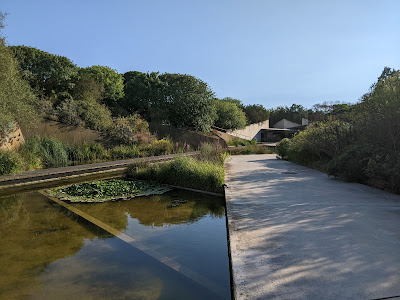If you love Mediterranean plants you'll love Jardi Botanic of Barcelona (Barcelona Botanical Garden) a beautiful 14 hectare site dedicated to Mediterranean plants form all over the world. The garden was established in 1999 on Montjuic Mountain, one of the largest green spaces within a city in Europe, and looks over the city, sitting adjacent to the Olympic stadium built for the 1992 Olympic games.
.jpg)
The garden is composed of various sections of the world's Mediterranean's namely, the Mediterranean basin, North Africa, California, Chile, South Africa and Australia. The Mediterranean climate is characterized by hot, dry summers and mild winters. Rain falls mostly in spring and autumn you can find this climate between 30° and 40° of latitude in the northern and southern hemispheres.
Only 1.7% of the Earth's land surface enjoys this climate however, Mediterranean flora accounts for approximately 20% of known plants and many endemic species and is some of the most beautiful wild plant compositions on the planet, especially so in mid spring.
I visited the garden in July and I totally recommend being in the garden in the last few hours before it closes (8.00pm) as the light shift brings out deeper color contrasts among the plants and it's a little cooler. If you want to enjoy the invertebrates, peak activity will probably be around 2.00 p.m.
Through the entrance and on the right is the Australia section, the air filled with the aroma of all kinds of Eucalyptus.
Situated up high on the mountain, you'll get some pretty spectacular views of Barcelona as you wander around.
I did not see much bird life in the garden although there are a fair number of Monk Parakeets - Myiopsitta monachus (I think) that are thought to have escaped from shipping crates at the airport or port some time ago and now naturalized in the area.
There is a small section of the garden dedicated to wildlife and food crops. As often the case with edible/wildlife displays in the majority of public gardens, it was lame in comparison to the rest of the garden. The usual insect hotel, herb spiral, and some fruit trees
Pretty sure insect hotels have been proven to be largely ineffective in terms of the variety of guests that take residence. A mosaic of habitat that includes wild native areas, and planting schemes that include a mixture of native and exotic plants with plenty of microhabitat is proven to be effective though and there were a number of areas around the gardens teeming with invertebrate life.
Always a pleasure to meet new plants, especially edibles. Argania spinosa is a medium-sized, spiny evergreen tree commonly grown in Southwest Morocco for its highly valuable oil. The leaves and fruit are edible but it's the oil from the seeds that are prized, being an excellent source of vitamin E and has a high nutritional value in the human diet.
The plant was laden with fruit. It caught my attention as a couple was collecting fallen fruits from under the tree. As well as its edibility Argania spinosa shields thin soils from erosion, especially in overgrazed lands. Its deep roots help to bind the soil, facilitate water infiltration and replenish groundwater. It's too sensitive to the cold to grow here in Shipka being more accustomed to USDA hardiness zones 10-12 but a great plant in the right climate.
One of the joys of growing a garden is that each plant you introduce comes with a story and a memory. A gift from a friend, a seed collected from a street tree on a rainy day, a plant bought from a Saturday market stall in a small village, a cheeky cutting taken while visiting a Botanic garden. I have plants collected from a landslide (definitely won't forget that one as it occurred on the road we drove past just a few minutes earlier). Love to know the story of this ancient Olive.
There are some magnificent Stone pine - Pinus pinea in the gardens, giving off a wonderful pine fragrance and providing much-needed shade.
I love the pink and orange-streaked bark
Being a garden of Mediterranean plants there are plenty of Palms throughout the gardens. Some species of palms do not shed their dead leaves, the result is what looks like a primitive beach hut.
Leucaena leucocephala, a small fast-growing mimosoid tree native to southern Mexico. This nitrogen fixing plant is a nutritious forage for domestic livestock when ingested in limited amounts although the plant contains mimosine, a plant amino acid, that can be toxic when ingested at higher concentrations.
Ochna serrulata The appearance of the black berries on red calyx inspired the alternative name "Mickey Mouse Plant".
The amount of variation in plant form is truly incredible and never ceases to amaze me. Even within similar designs, cacti, for example, the arrangement of protective spines is vast. Amusing to consider that via sheer awe of its majestic form, Cacti have ended up on the desks and windowsills of our homes and offices all over the planet.
This particular species (Euphorbia sp.) looks like it really does not want to be eaten, although I've recently been informed that it's a significant food source for Black Rhinoceros.
I noticed an Epiphyte on a Phoenix canariensis, a species of flowering plant in the palm family Arecaceae, native to the Canary Islands. An epiphyte is a plant that grows on another plant. In this case, it appeared to be a bramble- Rubus spp. that has seeded in a crevice where the old palm leaves have been cut off. It was making its way back down to the ground where it will likely take root.
There is an impressive water feature on the way out of the garden showing off some emergent and deep marginal aquatic plants and some great surrounding plantings. It's a really cozy part of the garden
That's all for this post!
Support Our Project
If you appreciate the work we are doing you can show your support in several ways.
Become a member of the Polyculture Project by subscribing to our Substack
Make a purchase of plants or seeds from our nursery or Online Store
Consider joining us for one of our Courses or Online Courses
Comment, like, and share our content on social media.
Make a direct donation via PayPal to balkanecologyproject@gmail.com

.jpg)




.png)















.jpg)











.jpg)



.jpg)






.jpg)




















